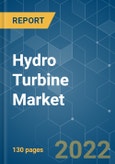The global hydro turbine market is expected to grow at a CAGR of more than 2.5% over the period of 2020-2025. Factors such as increasing demand for energy on a global scale, a rise in the need for cleaner technologies for power production, and stringent emission policy targets are likely to drive the hydro turbine market. Moreover, hydro power is the world’s largest source of renewable electricity generation, accounting for 15.9% of global electricity produced in 2018, and with new hydro power projects sanctioned, the demand for hydro turbines is expected to increase. However, certain drawbacks, such as design challenges of the turbine, ecological concerns related to dams, long gestation periods, and high installation cost of dams are hampering the growth of studied market.
Key Highlights
- Reaction turbine segment, by technology, of hydro turbine is expected to be the largest market during the forecast period, owing to increased use of reaction turbine types such as Francis turbine and Kaplan turbines.
- Expansion of energy intensive industries in African countries such as Nigeria, Angola, and Ghana are expected to provide a significant opportunity for hydro turbine market in the near future.
- Asia-Pacific is the largest market and is also expected to be the fastest growing market, owing to the highest annual increase in hydro power capacity in 2018, continuing the growth trajectory.
Key Market Trends
Reaction Turbine to Dominate the Market
- A reaction turbine develops power from the combined action of pressure and moving water. These turbines are used to generate maximum power output from a low available water head and high velocities. Almost 60% of turbines used in hydro power plants are reaction turbines.
- Francis turbines are from the reaction turbine class of hydro turbines and are the most widely used turbines in hydro power plants. As of 2017, almost 55% of the turbines installed at the existing facilities in the United States are Francis turbines.
- In May 2018, Bharat Heavy Electricals Limited (BHEL) secured a contract from SJVN Arun-3 Power Development (SAPDC) to implement the 900 MW Arun-3 hydroelectric project. Under the USD 80 million deal, BHEL is expected to design, manufacture, supply, and commission four vertical 225 MW Francis turbines and generator sets.
- Kaplan turbines are being installed in new power plant in countries, such as the United States, China, and India, as they are well-suited for the low-head sites and have better efficiency. Hence, promulgating the growth of hydro turbine market.
Asia-Pacific to Dominate the Market
- Asia-Pacific accounts for around 41% of hydroelectric consumption globally, with major demand arising from China and India. The region witnessed a growth of 4.2% in 2018 for hydroelectricity generation in comparison to 2017.
- China was the fastest growing country with respect to installed capacity of hydro power in 2018, adding 8.54GW. Over 90% of the added capacity in Asia-Pacific came from China, including 1.5 GW from pumped storage, which increased China’s total installed capacity to 352 GW. This, in turn, is expected to create ample opportunities for the hydro turbine market.
- In May 2018, the Government of India initiated the 1000 MW Pakal Dul hydroelectric project and the 330 MW Krishnaganga hydroelectric project in Jammu and Kashmir’s Kishtwar district. Moreover, countries such as Japan, Vietnam and South Korea have been investing in hydro power sector, promulgating the hydro turbine market.
- The hydro power industry, being the biggest end user of hydro turbines, has witnessed a significant growth in the recent years in Asia-Pacific, and is expected to be the fastest growing region.
Competitive Landscape
The hydro turbine market is moderately consolidated. Some of the key players are General Electric Co., Siemens AG, Andritz AG, Litostroj Power Group, and Voith GmbH & Co. KGaA.
Additional Benefits:
- The market estimate (ME) sheet in Excel format
- 3 months of analyst support
This product will be delivered within 2 business days.
Table of Contents
Methodology

LOADING...








